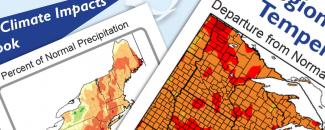
The contiguous United States just experienced its eighth warmest spring on record, with 19 states across the Rockies, Southern Plains, Southeast, and Midwest being much warmer than average. And, according to NOAA’s June–August temperature outlook, most of the United States is favored to have a hotter than average summer as well.
Only in the Great Plains do forecasters think the chances for a cool or a normal summer are equal to the chances of a hot summer. Everywhere else—from Alaska to southern California, and from Maine to Texas—odds are tilted toward well above average warmth. The absolute highest chances for a much warmer than usual summer are in Hawaii.
Spring also brought above normal precipitation to much of the contiguous United States, with 15 states in the Northwest, Central Plains, Mid-Mississippi Valley, Great Lakes, and Mid-Atlantic being much wetter than average. And, the Climate Prediction Center’s June–August precipitation outlook favors above average precipitation in the northern Great Plains and along the western Gulf Coast. Above average precipitation is also favored in central Alaska.
Impacts and Outlooks for Your Region
Get more details for your region in the June 2017 climate impacts and outlooks summaries:
- Alaska and Northwestern Canada Region
- Great Lakes Region
- Gulf of Maine Region
- Midwest Region
- Missouri River Basin
- Northeast Region
- Pacific Region
- Southeast Region
- Southern Region
- Western Region
Creating These Quarterly Summaries
NOAA’s Regional Climate Services Directors lead the production of these quarterly summaries of climate impacts and outlooks for various regions of the United States as well as parts of Canada along the border. This effort, which began in 2012, now includes as many as 10 unique regional products, all produced collaboratively with partner organizations.
Partnering with Canada
Since June 2016, NOAA’s Regional Climate Services Director for Alaska has been working with our Canadian collaborators from the Environment and Climate Change Canada Northwest Provinces to create a seamless joint summary for this region. Similarly, NOAA’s Regional Climate Services Director for the Eastern Region and for the Central Region have also worked with Environment and Climate Change Canada to create seamless assessments for the Gulf of Maine and Great Lakes regions. Our partnership with Canada helps us provide the tailored information these communities need to better understand their unique regional climates.
You can access all of the Climate Impacts and Outlooks summaries as well as additional reports and assessments through the U.S. Drought Portal Reports web page at Drought.gov.



